
Jimmystats: It's Offseason So Let's Talk About Football Jersey Numbers

UPDATE: A version of this published without the 2nd half of it and I didn't notice because I posted then ran out to pick up the kids.
A conversation in the last MGoPodcast on Rayshaun Benny's weird number (26) got me thinking that nobody has really put into words what certain jersey numbers mean in college football. I started working on a guide to what various numbers mean on various types of players, but 100 numbers is quite the undertaking, so I thought in the meantime I'd nerd out with some of the information I've picked up about jersey number assignment at Michigan.
WINNER!
#6 has been assigned 85 times since 1972, going out of circulation only once (1975), and capping at out four players in 2017.https://t.co/tFP6OSD7La pic.twitter.com/MBYhQ2XBTg— Seth M. Fisher (@Misopogon) April 6, 2022
Hard Rules
Offensive linemen have to wear numbers from 50-79, and non-linemen can't wear those numbers on offense or else they'll lose their receiver eligibility on the field. Michigan has retired #s 11 (for the Wistert brothers), 21 (Howard), 47 (Oosterbaan), 48 (Ford), 87 (Kramer) and 98 (Harmon). There were times when those numbers weren't retired of course—Ford's wasn't taken out of circulation until he was President, and Desmond Howard's #21 was retired recently.
Two players cannot wear the same # on the field at the same time (e.g. Michigan was penalized for having Andrel Anthony and Ja'den McBurrows on a late kickoff return together last year), which means guys who play special teams often occupy their digit for both offense and defense. Also #0 (and #00) were not assignable until last year.
Soft Rules
After a legend graduates his number often spends a year unused unless there's a high-profile recruit. Low numbers and prime numbers seem to have more value than higher numbers, and see more rotation as players switch to those numbers when they open up instead of wearing them for long careers. Double digits (22, 33, etc) are often a little more valuable than they would otherwise be. Some numbers have value because of their relationship to other numbers, e.g. 14 is a big number for quarterbacks because it's 7 (the QB number) times two. Harbaugh has a rule, most often noticed in practice rosters when freshmen are added, that you can take any number and the first guy who sees the field gets to keep it.
By Michigan Bylaw #22, if you wear #22, you must be a boring safety unless you're Ty Law.
Michigan Use History
I used 1972 as the cutoff for my study because that's the year freshmen became eligible and rosters expanded, meaning there were a lot more guys who needed numbers assigned and special digits were at a greater premium.
The most-often assigned jersey in this time was #6, followed by #3, a tie between #15 and #17, and #8.
Why isn't it just the coolest numbers? One of the factors is that a lot of the players who got lower digits were called upon to play both ways, or at least return kicks. A Charles Woodson coming through the program suppresses his number because nobody else can wear #2 when he's on the field in all three phases. Anthony Carter was such a big deal that Michigan held off from assigning #1 except when a receiver who seemed worthy came along, and after Braylon Edwards endowed it they stopped giving it out to anyone until Harbaugh ended that nonsense.
#6 and #3 benefited from rosters jam-packed with those digits. There were for #6s on the 2017 and 2018 rosters, three on the 1979, 2002, and 2016 teams, and more than one throughout the 2000s. Four of Harbaugh's first five teams had four guys wearing #3, until the practice was banned after the Fox announcers got confused. There were still three in 2016 and three in 1996, but got a bit of a break from double-ups for many years because Lloyd and Bo used it on specialists.
The story with #17 is it's the number most often used on multiple units. Will Hart shared with Sammy Faustin and Ty Wheatley Jr. Tony Anderson and David Cone had it at the same time. Sean Cassidy, a walk-on QB, wore it when Larry Foote did, etc. It's also the rare number that was doubled up under Bo, who let Ivan Hicks take the number Dwight Hicks had worn at Michigan without asking punter Rod Wood to change. #15 also got doubled up in the '80s, but its popularity with both offense and defense has kept it in circulation on both sides for all but three seasons (2006, 2007, and 2011) since 1998. Michigan's had a #8 on both offense and defense (but never more than two) every year since 1996 except 2000, 2001, 2011, and 2021 after William Mohan left the program.
Of the numbers that have been in full circulation, the least popular are #69, #74, #64, and #78. Broken down by group you can see offensive skill players snag the low numbers when they're allowed to, and defensive players tend to fill in, favoring the 50s (good for LBs and DL) and 90s.
The offensive players have to fight for the lowest numbers with defensive recruits, but they gobble up the numbers in the teens and low 20's. Offensive linemen tend to go for the low 70, which I think points to a convention of numbering centers in the 50s, guards in the 60s, and tackles in the 70s that still exists in high schools. Once all those high school tackles get on college rosters they're often converted inside, but retain their number preferences.
Here's the detail on offense:
One interesting thing was the tight ends taking the 80s while receivers squeezed into the lower numbers, with walk-on receivers filling in behind the fullbacks for numbers from the high 20s to the high 40s.
I was surprised that #77 and #78 weren't as popular as# 75, considering how many pro Ts have worn those numbers in their Wolverine careers. Michigan didn't have a #77 on the roster in 2008 or 2014, incidentally the worst two years of offensive line play at Michigan, but also the years after Jake Long and Taylor Lewan were the best LTs in the country. The story with 77 is it was the number Bo favored for his nose guards in the 1970s: Greg Morton was immediately followed by Mike Trgovac who was followed by Bob Tabachino (who converted to OL in 1982), then Ron Zielinski. Bo didn't like copying numbers, so #77 didn't become associated with Michigan left tackles until Tree Jenkins in 1991.
There's a similar story with #78, which went to Gabe Watson in the early aughts then had a run of OL who transferred in Justin Schifano and Dan O'Neill. Erik Magnuson is the only starter to wear it on offense since 2001. By contrast, #75 got a boost because walk-ons Chuck Hetts and Bud Gereg were allowed to share it with Bubba Paris and Jerry Quaerna in the late '70s and early '80s.
Seldon left before making the official roster as a #0.
On defense, by far the most popular number, weirdly, is the last one: #99, which was assigned to a guy playing defense 58 times over 50 years. The reason for this goes back to a practice during the Bo years of giving #99 to whoever was playing the weakside OLB position (Dominic Tedesco, Carlitos Bostic, Bob Thompson) and allowing a walk-on to wear it at the same time. There was also a short overlap with Jeff Smokevich and Jake Frysinger while the latter redshirted.
Other popular defender numbers are #93, #96, and #97. There are a few reasons for bunching guys into the late-90s. One is that for most of this time Michigan loaded up on defensive linemen. Often in the Mo and Lloyd years these guys who were recruited at DL and given a high-90s number would switch to offense after a couple of years and change to an OL digit. Also offensive players tended to stay away from the 90s, which meant defensive players with an eye to playing on special teams, or who just wanted to have a number to themselves, could take these numbers without fear of having to change it.
The most often assigned defensive numbers outside of the 90s were #55, #45, #58, and #56.
As with receivers, defensive backs tried to grab lower numbers, with walk-ons settling for unused numbers in the 40s. Linebackers went everywhere but preferred the 40s and 50s (or got stuck there) and left the 70s to the linemen.
Position Breakdown
QUARTERBACK
It's rare that some QB isn't wearing #12, even though McNamara was the rare starter to do so. The 5-stars tend to bunch around #7 and walk-ons are often filling in through the teens. Devin Gardner's two seasons at 98 were cool. Chip Pederson was listed with #89 in 1975 but I'm guessing he had a QB number before he was moved to tight end, the position he played the next three years.
RUNNING BACK
A few guys were able to nab single-digit numbers and some weirdos had jerseys in the teens, but the tailbacks mostly went for numbers around 23, with a handful going to 32 and 33 as numbers related to The RB number. Fullbacks filled in behind the RBs, or occasionally took numbers that signified they were quasi-tight ends. Many were walk-ons, and took a number in the high 30's.
WIDE RECEIVERS & TIGHT ENDS
There seems to be a tier of WR number choices. They go for the star numbers, #1 if they can get it, #9 when it's available, and fill into the teens when the cool low digits aren't on the table. A handful are always amenable to following the NFL's old precept of taking numbers in the 80s. The walk-on receivers—and there are always many—are often left with the dregs. They will take numbers in the 80s that aren't being used up by the tight ends, but often find themselves accepting something in the 20s (that a back is also wearing) or 30s.
Tight ends will scatter into the low digits, and more than a few fullbackian types will pull a number in the 30s or 40s, but they are much more likely—especially under Harbaugh—to take an 80s number. They really like 88, 89, and 80, but 83 is a popular choice as well.
OFFENSIVE LINE
The OL of course have to deal with a rule that restricts them to numbers from 50 to 79. Oddly, they tend to avoid #53. The linemen who did wear it: Jim Hackett (he was listed as an LB for 2 years, then a C his last two years so I wonder if that mean "C" as in what a middle linebacker used to go by?), Bill Schaffer, and Trente Jones. Anyway it bodes well for Jones's future earnings. The number of the beast is avoided too; the ways of hogmollies are strange and mysterious indeed. #75 is a popular choice, #70 is usually filled, and #65 is the most popular of the 60s.
You'll note a few get listed on the roster with a number in the 90s, and you've probably already guessed why: Michigan occasionally likes to have a lineman wear a TE number and come in as a 6th OL without sacrificing receiving eligibility. One of these days they're going to throw a pass to that guy, and there will be much rejoicing.
DEFENSIVE LINE
An occasional Rashan Gary (#3) or Carlo Kemp (#2) in recent years is a nice change of pace, but linemen usually end up with numbers in the 50s (because I'm a linebacker!) or the 90s (I'm a lineman.) More of them have begun to take numbers in the 70s and 80s this millennium, and the nose guards aren't congregating at 77 like they used to. #90 is a popular choice, and those guys seem to stick around a long time (Aghakhan, Feazell, Mone, Heuer), but #96 is the linemen favorite, with Will Carr, Ryan Glasgow, and John Herrmann representing it the best. There are a bunch of #53s here, which may account for the lack of them on the other side of the trenches.
LINEBACKER
Linebackers can wear just about anything. They don't fight for numbers in the 70s, and when they have a number in the 20s it's often because they moved from running back (a common thing among defensive backs too). The interesting thing is they also shy away from numbers in the 50s, which then get assigned to walk-ons. The mid-40s are where it's at, and mid-'30s. There are also a bunch of OLBs with numbers in the 90s, because they're really defensive linemen but don't want to call themselves that.
DEFENSIVE BACK
Backs technically could wear higher numbers but they almost never choose to. The walk-ons will get saddled with numbers in the late 30s and 40s while the stars will take the single-digits if they're available, and the teens and 20s when they're not. The standout here is #22, which was way more popular than I realized. I think of it as the Boring Safety number because of Lance Dottin, Jon Shaw, Jamar Adams, and Jarrod Wilson, or the "don't even bother throwing that way" cornerback number of Ty Law and David Long.
You're wondering about the dots on the right. Neil Ginley shows up just one year—1977—as a 6'2/190 DB. Eric Phelps promptly became a DE after 1973 and kept his #90. Anthony Capatina was a 5'9/180 walk-on who was listed at #95 in 2012 before changing to #41 when he became a WR.
SPECIALISTS
Everybody wear #3. Not you, walk-on kicker. You get a number in the 30s or 40s if it's available, and in the 90s if it's not.
who are some non-WR/TEs that have worn 80-89?
khalid hill was 80?
Hill was a TE to start his career and then just never changed.
Alan Branch was #80.
Craig Roh was 88
KC Lopata was 84
Glen Steele wore #81
I bet Glen began as a TE. He, most certainly, was an offensive terror at little West Noble HS in Northern Indiana. Being originally from that area, it was shocking to hear that Michigan found him-from the middle of nowhere.
There are a number of interesting facts in this post.
Indeed. I for one am absolutely primed to have a rational discussion about this. And it should be a completely positive topic, to do otherwise would be a cardinal sin.
Your days are numbered if you keep that up.
My question for the MGOBRAINZ is the extent to which numbers fluctuate after the spring game. I am very much interested in acquiring a Loveland jersey. His number for recruitment seemed to be 5 and his number in the spring game was 18. Should I wait until the official roster is released or can I safely order that name and number via mden now? 18 seems a bit out of the normal range value for TEs.
You're probably fine. He shares that number with a QB who's deep down the bench. A couple of concerns here are that the rest of the freshman class haven't claimed numbers yet, so he could get some competition, but unless someone wants to battle Loveland for it or he wants to switch to another number down the road I think you're fine as you can be at this point in his career. Usually I recommend waiting until a freshman is seeing the field to get his jersey though.
Remember, kids, zero is not a number.
vlady, another new avatar picture and I'm sure most of us know what he was doing when it was taken. heart breaking.
Wonder if a username change to Hotel Zelensky is in the works?
Still mad the NCAA stopped Harbaugh’s special teams shenanigans with #3.
Wonder when we will see double zero 00
I dont know how you write this whole article without mentioning how awesome it was when Devin Gardner wore 98 at QB!
Personally, I thought the legends number was really fun and think they should bring it back. Dave Brandon era was not awesome, but that was a cool wrinkle they had going for a few years.
It's in the follow-up.
I have a feeling the discussion with Brian about walk-on numbers involved a lot of nodding and silence from Brian with the occasional "ok" or "cool" sprinkled in.
No it was him trying to name numbers that denote walk-ons and I would be like "37 is Jarrett Irons and Erik Anderson" or "that number is retired for Bennie Oosberbaan" until he gave up.
Noodling around, I came across this article ( link ) that has Michigan All-Americans by jersey number.
Of the numbers that have been in full circulation, the least popular are #69,
shocking, really
#66 is also an unpopular number. I'm guessing there are some prudish parents of offensive linemen out there.
Do people equate 66 with 666? Can't say that would have even crossed my mind; would have figured 66 would have been popular since it's a double...
When I was a kid and noticed others smirking when anyone said "69," I asked a friend what it meant.
He passed along this pearl of wisdom: it refers to 6 minutes of pleasure and 9 months of pain.
I soon learned otherwise but, another benefit of a Michigan education, I experienced a much more interesting meaning.
I thought that the point was to avoid nine months of pain?
I have two children. Other pains do arrive after the nine months are over.
Chase Winovich put his number selection up to a poll on Twitter. He will be wearing #69 for the Browns.
Thanks. At least this time I don't feel innumerate.
One reason for TEs in the teens is some guys who start out at QB move to TE, yet keep their QB number. This happened more before Harbaugh. Examples: Jay Riemersma #16, Andy Mignery #14.
https://i.makeagif.com/media/2-28-2019/lWa7j0.gif
Tried to embed but I suck at life.
Well this is a rabbit hole.
I've never been more proud to support MGoBlog.
THIS is one of the posts that will remain in lore. It's a post we didn't know we needed, but which all of us find fascinating. And all of us have both very strong opinions on the topic which are formed by very powerful nostalgia.
This post has EVERYTHING a football nerd would want
It’s a numbers game.
When do you guys think CWood will get his number retired? (Although I believe Will Johnson will be great)
I was curious what mgoblog denizens would think are the ONE person associated with each number. Funny that during the podcast, very high on my list of number identities is that 37 IS Jarret Irons to me, but I'm a few years older than Brian and Seth. Others top of mind for me:
6 - Tyrone Wheatley
1 - AC
41 - Tommy Hendricks ('97 Notre Dame interception was THAT important)
77 - Jake Long
20 - Mike Hart
98 - Tom Harmon obviously
88 - Jake Butt
What are yours?
I'm in a weird spot with Irons. For some reason his jersey number doesn't stick in my head even though he does. I finally had the association down when he came on an MGoTheater3000 event, but then I lost it because Erik Anderson came on a history podcast and I watched a bucket of his games in prep.
Like languages I have one spot in my brain for 1997-2003ish players who straddled the period in college when I transitioned from kid who watches Michigan, to obsessive who got The Wolverine preview, turned to the roster pages, and made sure the NCAA Football game was accurate. So that part of the brain brings up Chris Graham at 37, and Prescott Burgess and Alijah Bradley sitting next to my friends both wearing 6, and A-Train in 32, etc.
Makes perfect sense. Because my four years in school overlapped exactly with Irons’. And we went from “Steve Morrison has graduated - we are dead!” to the opposite of that.
If memory serves he was injured for the Northwestern game in ‘96 which had a huge impact on how that game ended up.
For me ... #41 will forever be linked to Rob Lytle, the All-American running back from the mid-70s.
One of my all-time favorites: Mark Messner - 60.
for me #7 Rick Leach and #42 for Billy Taylor....
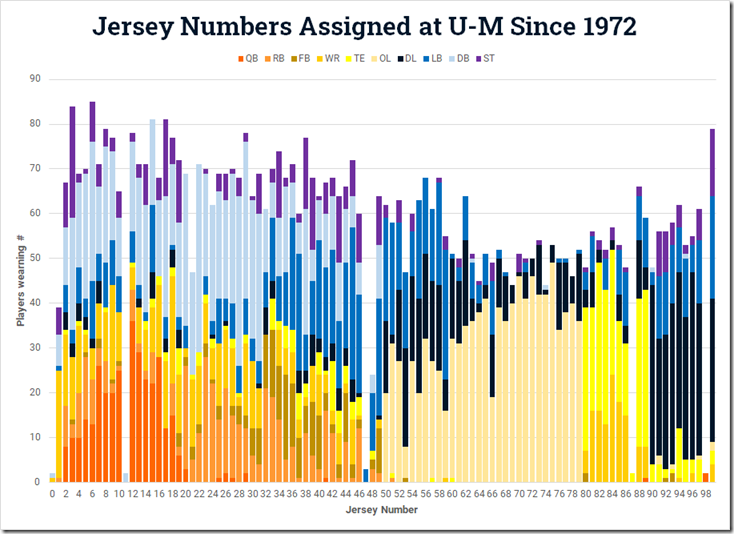
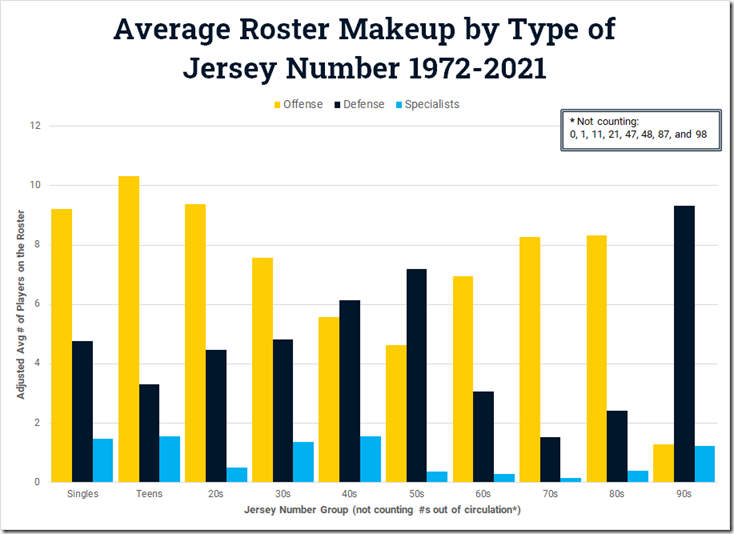
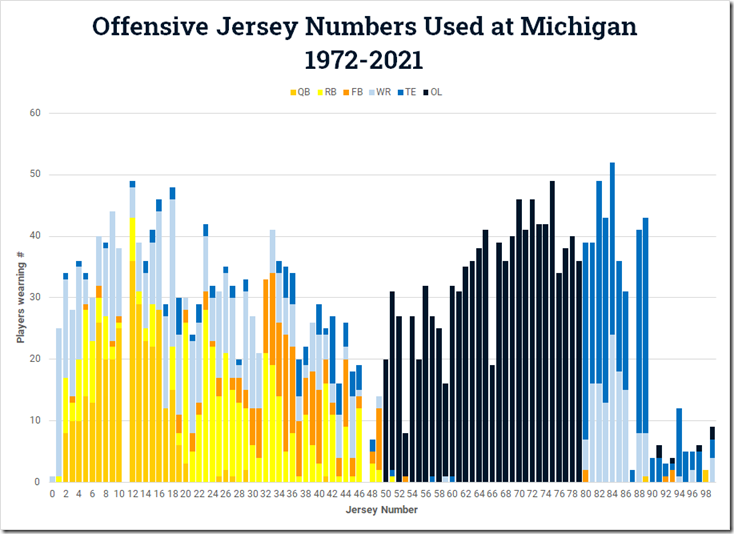
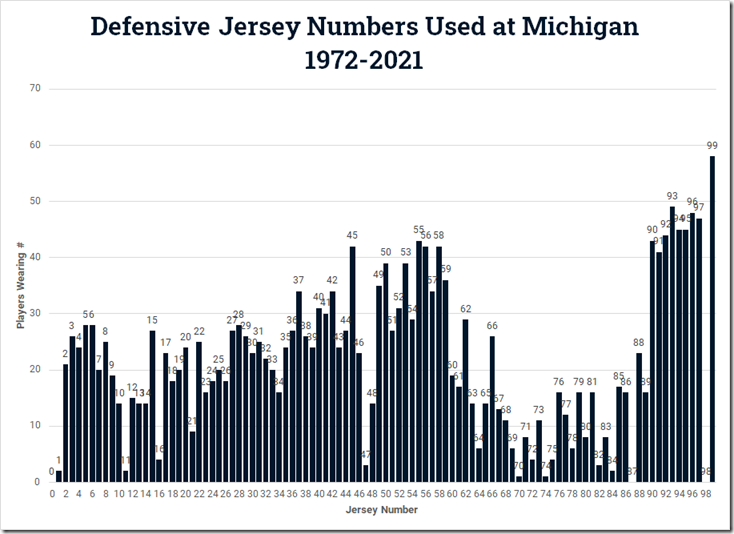

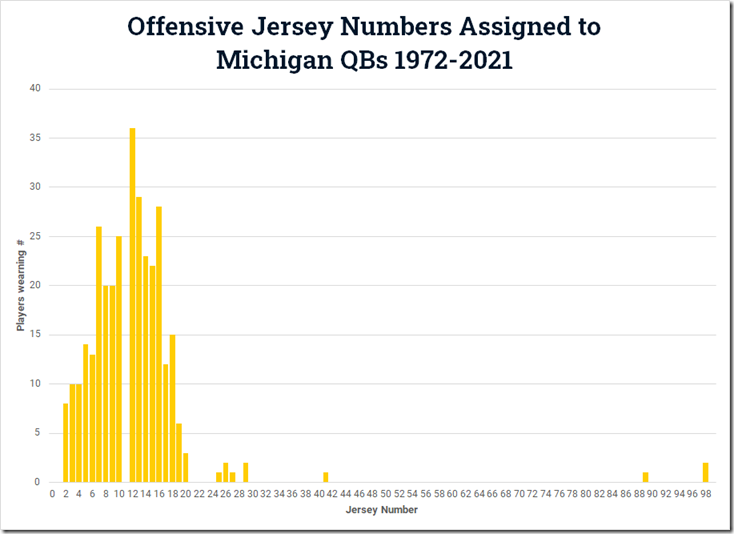

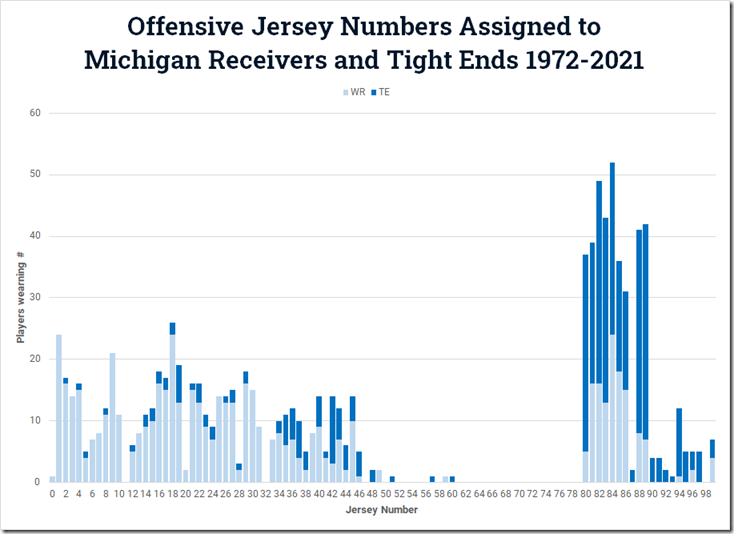
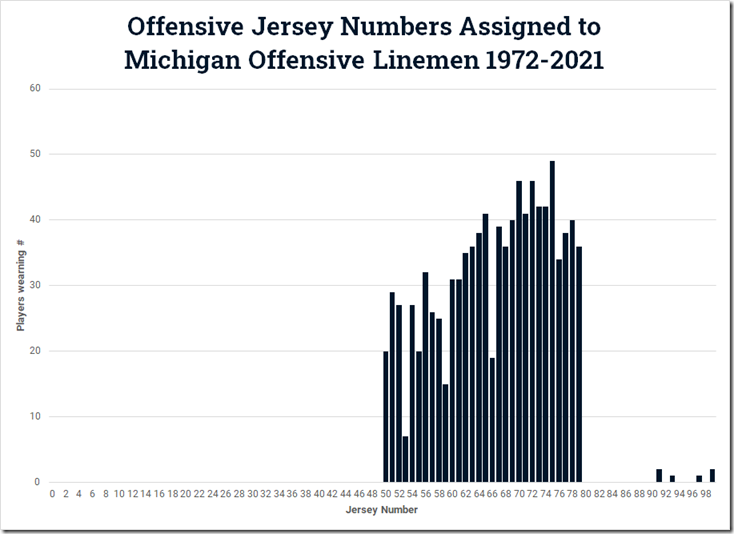
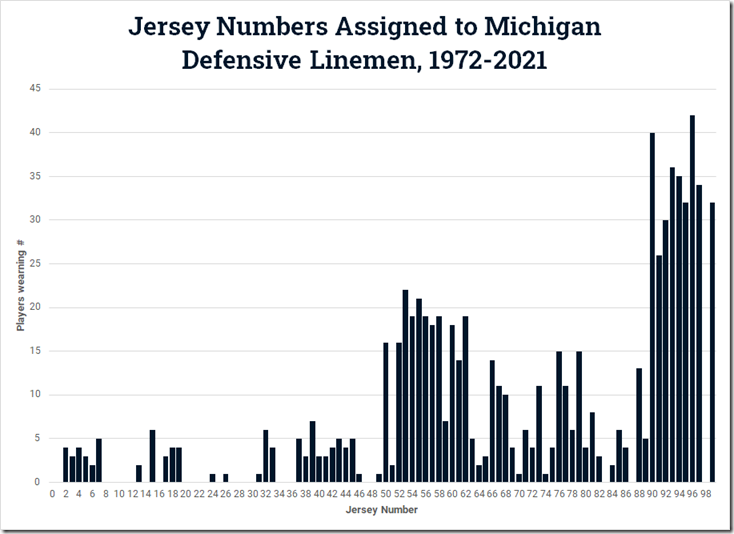
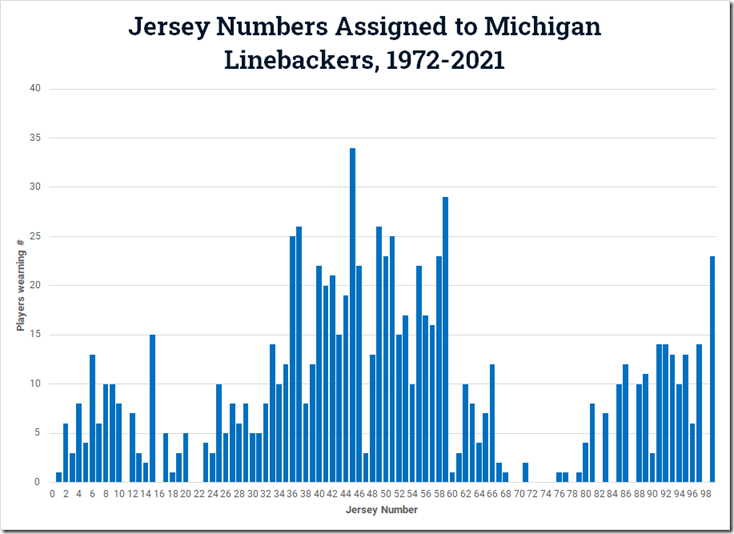

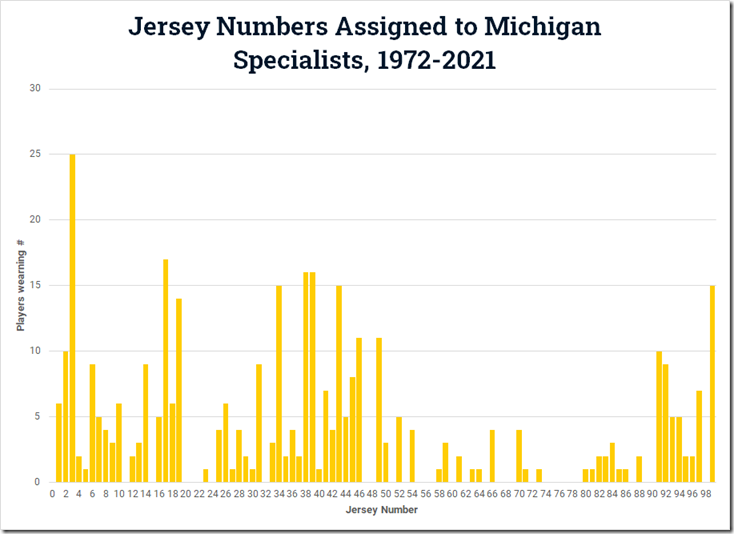
Comments